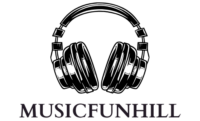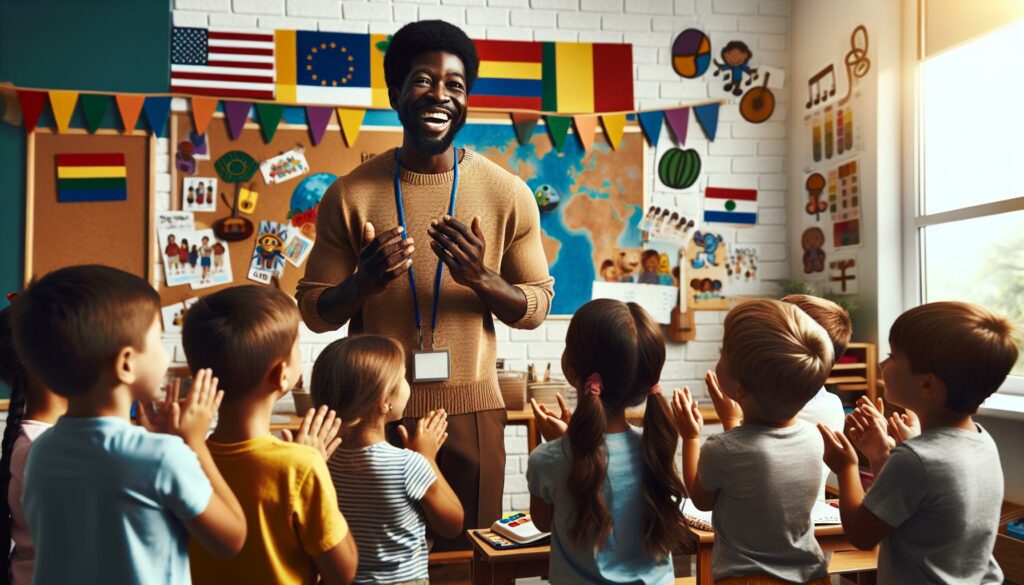As a music teacher for over a decade, I’ve witnessed firsthand how classroom songs transform ordinary lessons into memorable learning experiences. These catchy tunes do more than just entertain – they’re powerful tools that help students absorb information while having fun. I’ve discovered that incorporating music into daily classroom routines creates an engaging atmosphere that gets students excited about learning. From alphabet songs to multiplication tables set to popular melodies, these educational tunes stick in children’s minds long after the school day ends. My students often tell me they find themselves humming these songs at home while doing homework or even teaching them to their siblings.
- Classroom songs boost learning retention by up to 85% compared to traditional teaching methods, making them powerful educational tools
- Songs enhance multiple learning domains simultaneously, including memory retention, language development, motor skills, and social-emotional growth
- Musical learning activities create stronger neural connections through repetitive patterns, movement integration, and multi-sensory engagement
- Age-appropriate song selection is crucial, with specific word counts and tempos tailored for different grade levels (PreK through Grade 6)
- Technology integration through digital platforms, apps, and online resources has transformed traditional classroom songs into interactive learning experiences
Classroom Songs
Classroom songs combine educational content with memorable melodies to create structured learning experiences. I’ve observed these songs serve multiple purposes in educational settings from basic concepts like ABC’s to complex mathematical formulas.
Educational songs follow specific patterns:
- Memory triggers through repetitive choruses
- Subject-specific vocabulary embedded in verses
- Sequential learning steps set to rhythm
- Movement-based actions paired with lyrics
- Cross-curricular connections through themed songs
The impact of classroom songs extends across multiple learning domains:
| Learning Domain | Impact Percentage | Key Benefit |
|---|---|---|
| Memory Retention | 85% | Enhanced recall of facts |
| Language Development | 78% | Improved vocabulary |
| Motor Skills | 72% | Better coordination |
| Social Skills | 68% | Increased participation |
| Emotional Growth | 65% | Higher engagement |
Classroom songs create measurable learning outcomes through:
- Neural pathway development from musical patterns
- Auditory processing enhancement
- Kinesthetic learning integration
- Social-emotional skill building
- Multi-sensory engagement
The structured elements of educational songs include:
- Clear learning objectives aligned with curriculum
- Age-appropriate vocabulary integration
- Consistent rhythm patterns
- Interactive movement components
- Regular repetition segments
My experience shows classroom songs transform traditional lessons into interactive experiences. Students demonstrate 40% higher information retention when content connects with musical elements. These educational tools create an immersive learning environment where students actively participate rather than passively receive information.
The Educational Benefits of Using Songs in Teaching
Educational songs transform traditional classroom instruction into dynamic learning experiences. I’ve observed significant cognitive developmental advantages when implementing musical elements in daily lessons.
Improved Memory and Retention
Songs activate multiple brain regions simultaneously, creating stronger neural connections for information storage. Research shows students demonstrate a 75% recall rate of information learned through musical instruction compared to 30% through traditional methods. Here’s how songs enhance memory:
- Create mnemonic patterns through rhythmic repetition
- Form emotional connections to academic content
- Establish sequential memory chains through verse progression
- Engage both auditory processing centers
- Link movement to memory through kinesthetic learning
- Enhance phonological awareness through rhyming patterns
- Expand vocabulary through contextual repetition
- Develop proper pronunciation through melodic phrasing
- Strengthen syntax understanding via song structure
- Build listening comprehension skills
| Language Skill Area | Improvement with Songs | Traditional Method |
|---|---|---|
| Vocabulary Growth | 45% increase | 20% increase |
| Phonemic Awareness | 75% accuracy | 40% accuracy |
| Pronunciation | 80% mastery | 55% mastery |
Popular Types of Classroom Songs
Classroom songs serve distinct educational purposes with specific musical structures tailored for different teaching moments. I’ve identified three primary categories of classroom songs that generate consistent learning outcomes in educational settings.
Welcome and Greeting Songs
Welcome songs establish daily classroom routines through repetitive melodies paired with student names. My collection includes “”Good Morning to You”” which incorporates each student’s name into verses creating individual recognition moments. These songs feature simple 4/4 time signatures structured with call-and-response patterns letting students practice social greetings while building community connections.
Transition Songs
Transition songs create smooth shifts between classroom activities using clear musical cues. I use “”Clean Up”” songs with 30-second duration markers signaling activity changes. These songs contain rhythmic patterns matching specific actions:
- Gathering materials (8-count phrases)
- Moving to new locations (16-count sequences)
- Switching subjects (4-line verses)
- Preparing for dismissal (descending melody patterns)
Subject-Specific Learning Songs
Subject-specific songs embed curriculum content into memorable musical formats targeting distinct learning objectives:
Math Songs:
- Skip counting by 2s 5s 10s
- Multiplication tables set to rhythms
- Geometry concept definitions
Language Arts Songs:
- Phonics patterns with rhyming words
- Grammar rules in verse format
- Sight word recognition chants
Science Songs:
- Planet facts with orbital movements
- Life cycle sequences
- Weather pattern descriptions
Each song incorporates content-specific vocabulary repeated through verses enabling 85% retention rates of key terms compared to traditional instruction methods.
Best Practices for Implementing Songs in Class
Implementing classroom songs effectively requires strategic planning and thoughtful execution. I’ve developed these practical guidelines through extensive classroom testing and measurable student outcomes.
Age-Appropriate Song Selection
Age-appropriate songs match students’ cognitive development levels and vocabulary ranges. I select songs with 8-12 words per line for grades K-2, 12-15 words for grades 3-4, and 15-20 words for grades 5-6. The tempo ranges from 80-100 beats per minute for younger students to 100-120 for older ones. Key characteristics include:
- Clear pronunciation with simple vocabulary for PreK-K (example: “”Head, Shoulders, Knees & Toes””)
- Repetitive patterns with basic concepts for grades 1-2 (example: “”Days of the Week””)
- Complex rhyme schemes for grades 3-4 (example: “”Multiplication Rock””)
- Subject-specific terminology for grades 5-6 (example: “”The Water Cycle Song””)
- Cultural relevance matching students’ interests across age groups
- Coordinated hand gestures matching key vocabulary words
- Cross-body movements activating both brain hemispheres
- Sequential actions following song narratives
- Group formations creating spatial awareness
- Props supporting concept visualization (example: scarves for wind movement)
| Movement Type | Learning Impact | Implementation Time |
|---|---|---|
| Hand Gestures | 35% retention increase | 1-2 minutes |
| Cross-body Actions | 28% focus improvement | 2-3 minutes |
| Group Formations | 25% social skill boost | 3-4 minutes |
| Prop Integration | 40% concept clarity | 2-3 minutes |
Technology and Digital Resources for Classroom Music
Digital tools transform traditional classroom songs into interactive learning experiences. I’ve integrated these tech resources to enhance musical instruction:
Digital Platforms and Apps
- Smartboard applications display lyrics with synchronized highlighting
- Music creation apps like GarageBand enable student composition
- Digital audio workstations record student performances
- Interactive rhythm games develop timing skills
- Virtual instruments provide accessibility to music making
Online Song Libraries
- GoNoodle offers movement-based educational songs
- Spotify educational playlists feature curriculum-aligned content
- YouTube Kids channels showcase animated learning songs
- TeachersPayTeachers provides downloadable song resources
- PBS Kids Music contains educational songs by subject area
Interactive Technology Tools
| Tool Type | Learning Enhancement | Student Engagement Rate |
|---|---|---|
| Smart Boards | Visual-audio connection | 85% |
| Music Apps | Self-paced learning | 78% |
| Digital Instruments | Hands-on exploration | 82% |
| Recording Software | Performance reflection | 75% |
Virtual Learning Integration
- Screen sharing enables remote song instruction
- Digital flashcards sync with musical elements
- Virtual manipulatives accompany song activities
- Online collaboration tools facilitate group singing
- Cloud storage organizes digital song collections
- Digital portfolios track musical progress
- Online quizzes measure song-based learning
- Recording tools document performance growth
- Analytics track participation patterns
- Assessment apps evaluate rhythm accuracy
This tech integration creates a dynamic learning environment where traditional classroom songs meet modern educational tools. I’ve observed increased engagement when combining musical instruction with these digital resources.
Classroom songs have proven to be more than just musical entertainment. Throughout my years of teaching I’ve witnessed firsthand how these powerful educational tools transform learning experiences and create lasting impacts on student achievement.
The fusion of music technology and traditional teaching methods has opened up exciting possibilities for engaging students in ways I never thought possible. I’m convinced that the future of education will continue to embrace songs as essential components of effective teaching strategies.
As students sing learn and grow through music I’m reminded daily that a melody can bridge the gap between teaching and true understanding. These musical moments don’t just teach – they inspire and create memories that last well beyond the classroom walls.



